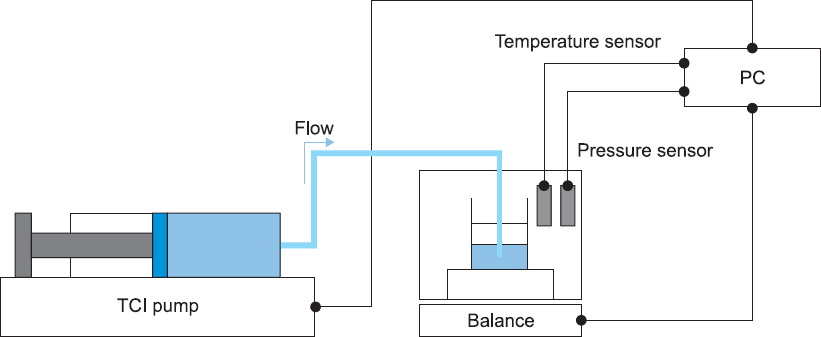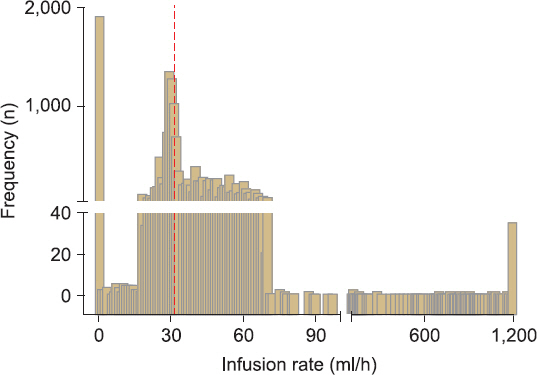Anesth Pain Med.
2019 Oct;14(4):407-411. 10.17085/apm.2019.14.4.407.
Accuracy assessment of a PION TCI pump based on international standards
- Affiliations
-
- 1Center for Medical Metrology, Korea Research Institute of Standards and Science (KRISS), Daejeon, Korea.
- 2Center for Thermometry and Fluid Flow Metrology, Korea Research Institute of Standards and Science (KRISS), Daejeon, Korea.
- 3Department of Anesthesiology and Pain Medicine, Asan Medical Center, University of Ulsan College of Medicine, Seoul, Korea. byungmoonchoi7@gmail.com
- 4Department of Clinical Pharmacology and Therapeutics, Asan Medical Center, University of Ulsan College of Medicine, Seoul, Korea.
- KMID: 2465337
- DOI: http://doi.org/10.17085/apm.2019.14.4.407
Abstract
- BACKGROUND
Inaccuracies associated with target-controlled infusion (TCI) delivery systems are attributable to both software and hardware issues, as well as pharmacokinetic variability. However, little is known about the inaccuracy of the syringe pump operating in TCI mode. This study aimed to evaluate the accuracy of the TCI pump based on international standards.
METHODS
A test apparatus for accuracy evaluation of a syringe pump (PION TCI®, Bionet Co. Ltd.) was designed to apply the gravimetric method. Pump accuracy was evaluated in terms of deviation defined by the following equation: infusion rate deviation (%) = (Rate(mea) − Rate(est)) / Rate(est) × 100, where Rate(mea) is the infusion rate (ml/h) as measured by the gravimetric system, and Rate(est) is the infusion rate (ml/h) as estimated by the pump. An infusion rate representing TCI mode was determined from previous clinical trial data which evaluated the predictive performance of the pharmacokinetic model. The PION TCI pump used in that clinical trial was used to evaluate accuracy of the syringe pump. The distribution of infusion rates obtained from the clinical trial was calculated, and the median value of the distribution was determined as the representative value.
RESULTS
The representative infusion rate representing TCI mode was 31 ml/h, at which the infusion rate deviation was 4.5 ± 1.6%.
CONCLUSIONS
The inaccuracy of the syringe pump contributing to TCI system inaccuracy is insignificant.
Figure
Reference
-
1. Absalom AR, Glen JI, Zwart GJ, Schnider TW, Struys MM. Target-controlled infusion:a mature technology. Anesth Analg. 2016; 122:70–8. DOI: 10.1213/ANE.0000000000001009. PMID: 26516798.2. Struys MM, De Smet T, Glen JI, Vereecke HE, Absalom AR, Schnider TW. The history of target-controlled infusion. Anesth Analg. 2016; 122:56–69. DOI: 10.1213/ANE.0000000000001008. PMID: 26516804.3. Absalom AR, Mani V, De Smet T, Struys MM. Pharmacokinetic models for propofol--defining and illuminating the devil in the detail. Br J Anaesth. 2009; 103:26–37. DOI: 10.1093/bja/aep143. PMID: 19520702.4. Park JH, Choi SM, Park JH, Lee KH, Yun HJ, Lee EK, et al. Population pharmacokinetic analysis of propofol in underweight patients under general anaesthesia. Br J Anaesth. 2018; 121:559–66. DOI: 10.1016/j.bja.2018.04.045. PMID: 30115253.5. Ki SH, Rhim JH, Park JH, Han YJ, Cho YP, Kwon TW, et al. Quantitative analysis of the effect of end-tidal carbon dioxide on regional cerebral oxygen saturation in patients undergoing carotid endarterectomy under general anaesthesia. Br J Clin Pharmacol. 2018; 84:292–300. DOI: 10.1111/bcp.13441. PMID: 28940441. PMCID: PMC5777433.6. Yi JM, Doh I, Lee SH, Kim SY, Lee YH, Lee EK, et al. Predictive performance of a new pharmacokinetic model for propofol in underweight patients during target-controlled infusion. Acta Anaesthesiol Scand. 2019; 63:448–54. DOI: 10.1111/aas.13335. PMID: 30690713.7. Varvel JR, Donoho DL, Shafer SL. Measuring the predictive performance of computer-controlled infusion pumps. J Pharmacokinet Biopharm. 1992; 20:63–94. DOI: 10.1007/BF01143186. PMID: 1588504.8. International Electrotechnical Commision IEC 60601-2-24 2012. Medical electrical equipment part 2-24:particular requirements for the basic safety and essential performance of infusion pumps and controllers. 2nd ed. Geneva: International Electrotechnical Commision;2012.9. Lee SH, Kang W, Chun S. Dynamic behavior analysis of drug delivery devices using a dynamic gravimetric method. Flow Meas Instrum. 2018; 62:105–12. DOI: 10.1016/j.flowmeasinst.2018.03.009.10. Choi BM, Lee HG, Byon HJ, Lee SH, Lee EK, Kim HS, et al. Population pharmacokinetic and pharmacodynamic model of propofol externally validated in children. J Pharmacokinet Pharmacodyn. 2015; 42:163–77. DOI: 10.1007/s10928-015-9408-2. PMID: 25724290.11. International Organization for Standardization ISO 4185:1980. Measurement of liquid flow in closed conduits--weighing method. Geneva: ISO;1980.12. Glen JB, Servin F. Evaluation of the predictive performance of four pharmacokinetic models for propofol. Br J Anaesth. 2009; 102:626–32. DOI: 10.1093/bja/aep043. PMID: 19297371.13. Lee SH, Park HW, Kim MJ, Noh MH, Yoon HS, Choi BM, et al. External validation of pharmacokinetic and pharmacodynamic models of microemulsion and long-chain triglyceride emulsion propofol in beagle dogs. J Vet Pharmacol Ther. 2012; 35:329–41. DOI: 10.1111/j.1365-2885.2011.01321.x. PMID: 21790660.14. Vereecke HE, Eleveld DJ, Colin P, Struys MM. Performance of the Eleveld pharmacokinetic model to titrate propofol in an obese Japanese patient population. Eur J Anaesthesiol. 2016; 33:58–9. DOI: 10.1097/EJA.0000000000000280. PMID: 26086291.15. Lee YH, Choi GH, Jung KW, Choi BH, Bang JY, Lee EK, et al. Predictive performance of the modified Marsh and Schnider models for propofol in underweight patients undergoing general anaesthesia using target-controlled infusion. Br J Anaesth. 2017; 118:883–91. DOI: 10.1093/bja/aex102. PMID: 28541533.16. Neff SB, Neff TA, Gerber S, Weiss MM. Flow rate, syringe size and architecture are critical to start-up performance of syringe pumps. Eur J Anaesthesiol. 2007; 24:602–8. DOI: 10.1017/S0265021506002328. PMID: 17261217.17. Adapa RM, Axell RG, Mangat JS, Carpenter TA, Absalom AR. Safety and performance of TCI pumps in a magnetic resonance imaging environment. Anaesthesia. 2012; 67:33–9. DOI: 10.1111/j.1365-2044.2011.06917.x. PMID: 21972913.
- Full Text Links
- Actions
-
Cited
- CITED
-
- Close
- Share
- Similar articles
-
- Predictive performance of a target controlled infusion of Aquafol(TM) by use of a PION TCI(R) pump
- Efficacy evaluation of syringe pump developed for continuous drug infusion
- A Study on the Internationalization of Korea’s Aircraft Maintenance Personnel Qualification System and Training
- Propofol target-controlled infusion for gastrointestinal endoscopy
- Introduction to International Ethical Standards Related to Genetics and Genomics



